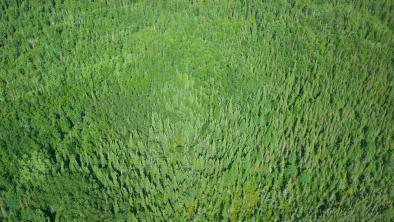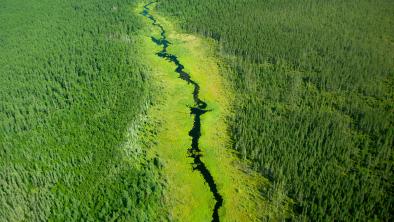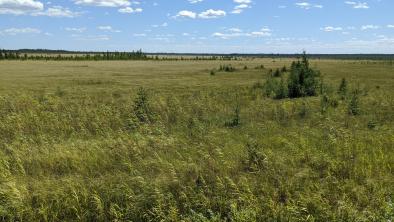Going in the Wrong Direction with Park Peat Mines

Yesterday morning I joined four other bleary-eyed Manitobans gathering in St. Boniface before dawn. Munching on toast and slurping down coffee, we loaded up the truck with winter hiking gear and headed off. We were headed out on a day expedition to Hecla / Grindstone Provincial Park to check out this Hay Point peat bog that everyone is talking about. Hopefully you’ve heard that Sun Gro Horticulture has applied for a license to strip mine it so we wanted to see it firsthand.
My companions on this trip were Dylan Hewlett from The Uniter (the University of Winnipeg newspaper), Leif Larsen from The Manitoban (the University of Manitoba newspaper) and rabble.ca, Kaeleigh Ayre from EcoPIA (the University of Winnipeg’s student eco group) and Eric. On the way out, I was so inspired by the natural beauty surrounding me that I promptly fell asleep for the duration of the drive. They roused me as we entered the park, and we pulled off the road just to the east of the proposed mine site.
We geared up and headed into the pathless woods, following our intrepid leader Eric. After a few minutes we stopped to assess our progress. After a compass was pulled out and a GPS was consulted, we found we were veering south, and we headed off in a new direction. A little while later we checked our bearings again. To all of our astonishment, since looking over our maps, we had been going 180 degrees in the wrong direction—even more off course than the first time! Basically we took the scenic route, winding through the woods, and eventually found the pond that would act as our landmark.
At this point the trees were shorter and scraggly. The vegetation was noticeably different than what we’d seen when we first parked the truck. Peat bogs are such an acidic and nutrient-poor environment that vegetation is very slow-growing and different from a typical forest. The snow covered a spongy layer of moss, and the lack of tall trees left the sky wide open above us.
We crossed the pond and followed a cut line, and then veered off into the proposed mine location. It looked much like all the other bogs we’d just seen. The hillocks of sphagnum moss grow unevenly and were awkward to walk through, while the views were limited by the lack of elevation change. This part of Hecla / Grindstone Provincial Park is not all breathtaking vistas and scenic overlooks. Likely there is a reason why nobody hikes here, and unfortunately, this makes it harder for people to recognize the area’s value.
The greatest value of peat bogs isn’t their natural beauty, but what lies beneath. Peat bogs store staggering amounts of carbon. The moment bogs are drained, the dead mosses which make up the peat begin decomposing and release huge amounts of carbon into the air. Not only does mining peat add carbon to the atmosphere, it removes the peat bog’s ability to capture carbon. Peat mining takes away a positive climate change effect and replaces it with a huge negative!
Very simply, we need peat bogs. And we also need provincial park protection. So even though you’ll probably never hike where we went yesterday, we need you to voice your opinion on the proposed peat mine in a park before next Friday, February 3, 2012. You can do this right now by visiting our letter-writing tool HERE.
— Kalyn


